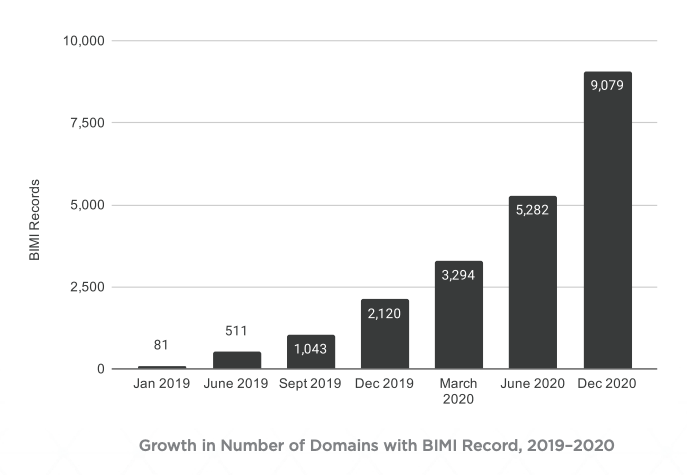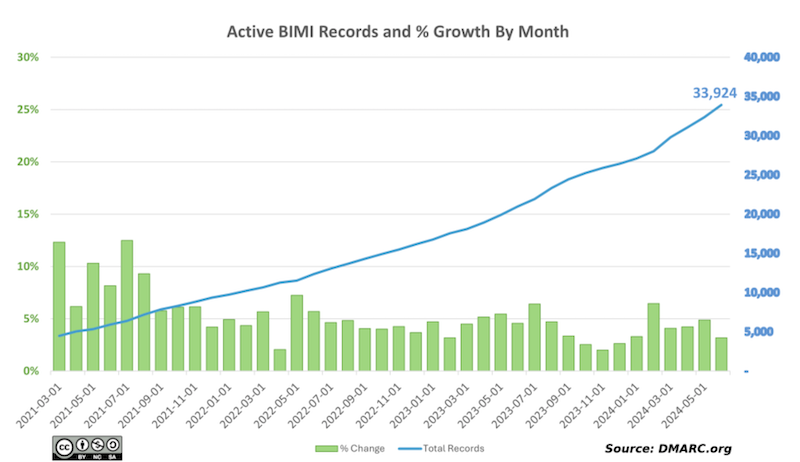After a dramatic surge in adoption since mid-2020, BIMI seems to be becoming an email marketing must-have.
According to DMARC.org in mid-2024, nearly 34,000 unique and valid BIMI records were observed and still remain active in DNS today. (BIMI), an email standard for showcasing a brand's logo next to its email messages in recipient inboxes, with built-in protections against phishing-based brand spoofing.
That's a 378% increase in BIMI adoption since December 2020. (See graph below with domain volume growth back from 2019-2020 from Fortra's H1 2021 Email Fraud & Identity Trends Report.)
Compare to DMARC.org's recent graph of BIMI adoption growth.

Gmail’s ongoing BIMI pilot certainly helped to jump-start this growth. So too has the changing nature of consumers’ interactions with brands and retail experiences upended by the pandemic. With millions stuck at home due to lockdowns, email has never been more crucial to customer support and marketing—but that dependence on email also exposed consumers and employees to a surge in phishing and business email compromise (BEC) scams.
BIMI is part of the solution to challenges like these. It gives marketers a way to make their messages stand out in overcrowded inboxes. It also works something like the email version of the blue checkmarks used to verify social media accounts, making it harder for fraudsters to pose as trusted brands.
Hijacking Your Brand—Hook, Line & Sinker
As the primary and preferred means of communications between customers and the brands they do business with, ecommerce partner, Omnisend, maintained in late 2023 that email returns $36-40 for every $1 spent. According to the FBI's 2023 IC3 report, losses due to Business Email Compromise attacks were up by nearly 551 million between 2021-2023. And according to Statista, 26% of US-based impersonation cases used email as the primary vector for delivery, up from 10% in 2020.
When brands get impersonated, they're likely to face lost business – and in some circumstances, even possible exposure to legal liabilities. And brand abuse erodes customer trust, causing senders’ legitimate email messages to become repellent to recipients–if they're even delivered. When fraudsters spoof email domains in phishing attacks, those servers can get blacklisted, decimating critical email-based revenue streams at the worst possible time. That's where BIMI comes in.
BIMI: Reinforcing Trust with Email Authentication
First introduced in 2018, BIMI was developed by a coalition of email industry leaders. At its most essential, BIMI provides a mechanism for enabling email messages to be accentuated with a brand logo in a special space controlled by the inbox provider—usually next to the email subject line in the recipient's inbox, and in the upper left corner of the email message itself, outside the email body.
BIMI requires that the email has been authenticated using the Domain-based Message Authentication, Reporting & Conformance (DMARC) protocol, which stops billions of email-based brand impersonation attacks each year. Additionally, the brand logo itself must be certified with a Mark Verifying Authority (MVA), a third party organization that can provide evidence of verification of certain standards, including size, trademark, and content.
Not only does BIMI help increase brand impressions and visual impact, but the logo itself is verified by both the sender and recipient's email systems, so it can't be faked.
Boosting the Brand, and the Bottom Line
Together with its DMARC underpinnings, BIMI rewards organizations for having proper email security by increasing their brand visibility. It’s a win for email security, brand protection, and consumer trust. It can also come with a big payoff.
When implemented using email ecosystem management solutions, DMARC been shown to increase email deliverability, while boosting email response rates by 10%. By providing a visual cue to confirm a message's authenticity, a BIMI-enabled brand logo can only help bolster customer trust over time, possibly fueling further increases in email marketing conversion rates.
In addition to Gmail, other major inbox providers such as Yahoo/AOL, Netscape, Fastmail have seen enough promise in BIMI to launch pilots in support of it, and we expect rollouts to reach an expanded scale this year. Once they do, BIMI is sure to blast off.
As VentureBeat put it back in 2020, "While BIMI is partly about creating a consistent brand image across email clients and services. it's also designed to bring some peace of mind to email recipients who can instantly see that the sender is who they claim to be."
